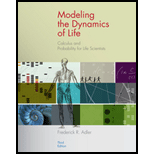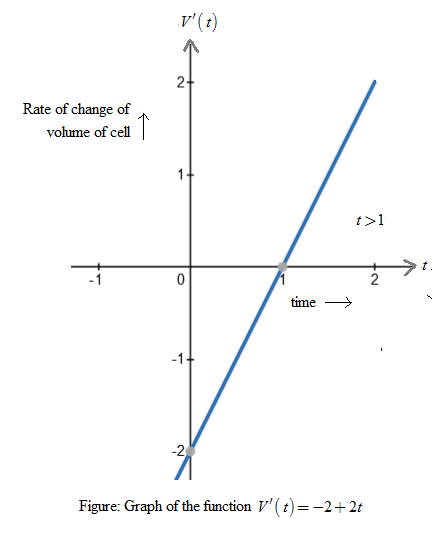
Concept explainers
a.
To graph:The secant line to the given curve from time
a.
Explanation of Solution
Given:
The volume of a cell as a function of time is given by
Method used:
The graph is sketched using graphic calculator.
Graph:
The graph of function and the secant from

Interpretation:
The curve represented by the function
b.
To find:The equation of secant line at points
b.
Answer to Problem 28SP
The equation of secant joining the points
Explanation of Solution
Given:
The curve in part (a), and secant passes through points
Formula used:
The equation of a line to the curve
Calculation:
The given curve is
Hence, the equation of secant joining the points
Conclusion:
The equation of secant joining the points
c.
To find: The derivative of function
c.
Answer to Problem 28SP
The derivatives of
Explanation of Solution
Given:
The function
Formula used:
The derivative of
Calculation:
The given function is
The derivative of
Conclusion:
The derivatives of
d.
To find: The cell volume
d.
Answer to Problem 28SP
The volume of the cell at
Explanation of Solution
Given:
The expression for
Concept used:
Substitute
Calculation:
The expression for
Therefore, the volume of the cell at time
But volume is measured in 1000 s of
Hence, the measured volume of the cell at
Conclusion:
The volume of the cell at
e.
To graph: The derivative of function
e.
Explanation of Solution
Given:
The derivative of
Concept used:
The graph is plotted using graphic calculator
Graph:
The graph of the derivative of function

Interpretation:
The graph of the derivative of volume function
Want to see more full solutions like this?
Chapter 2 Solutions
Modeling the Dynamics of Life: Calculus and Probability for Life Scientists
 Advanced Engineering MathematicsAdvanced MathISBN:9780470458365Author:Erwin KreyszigPublisher:Wiley, John & Sons, Incorporated
Advanced Engineering MathematicsAdvanced MathISBN:9780470458365Author:Erwin KreyszigPublisher:Wiley, John & Sons, Incorporated Numerical Methods for EngineersAdvanced MathISBN:9780073397924Author:Steven C. Chapra Dr., Raymond P. CanalePublisher:McGraw-Hill Education
Numerical Methods for EngineersAdvanced MathISBN:9780073397924Author:Steven C. Chapra Dr., Raymond P. CanalePublisher:McGraw-Hill Education Introductory Mathematics for Engineering Applicat...Advanced MathISBN:9781118141809Author:Nathan KlingbeilPublisher:WILEY
Introductory Mathematics for Engineering Applicat...Advanced MathISBN:9781118141809Author:Nathan KlingbeilPublisher:WILEY Mathematics For Machine TechnologyAdvanced MathISBN:9781337798310Author:Peterson, John.Publisher:Cengage Learning,
Mathematics For Machine TechnologyAdvanced MathISBN:9781337798310Author:Peterson, John.Publisher:Cengage Learning,






